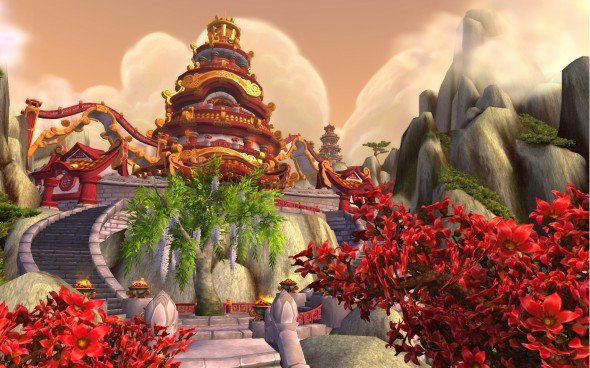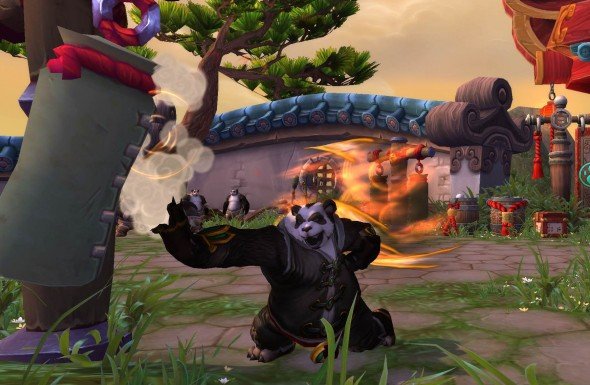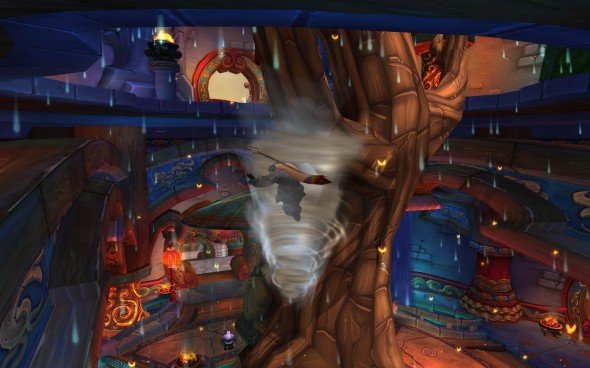World of Warcraft: Mists of Pandaria preview

I started my huggable journey on the back of a giant turtle. The Wandering Isle is a set of villages, hills, and lakes situated on the back of a gently floating reptile. It's home to all fresh Pandarens, curious enough about the outside world to hitch a lift on the panda version of public transport. I'd chosen to make my man-panda a monk. Monks are Mists of Pandaria's new class choice – the only one in the expansion – and they chime well with the race's eastern aesthetics.
Monks balance three resources. Chi acts as mana, and lets me deliver my panda's punchy powers. Complete certain moves, and I was awarded with pips of light and dark energy, the fuel for different types of attacks. It leads to a nice rhythmic combat style: I'd jab an enemy a few times, exhausting my chi but filling my boots with light energy, then let fly with a tougher, energy-using thwack. That rhythm is compounded by the lack of an auto-attack: every time you dive your panda into a dust-up, you'll need to be tapping the keys lest your opponent turn your black eyes blacker.
Blizzard namechecked Street Fighter as an influence in the monk's fighting style, but where the difference between a Zangief and a Chun-Li is obvious in that game, it's harder to see where the Monk slots into the pantheon of WoW classes. BlizzCon gives the title's most obsessive fans licence to ask detailed questions of the game's developers, and a good percentage of those directed at this year's panel were attempts to clarify exactly what the Monk does.
Blizzard suggested that the Monk was a melee scrapper, but could be press-ganged into bot-absorbing damage (tanking) and fixing fluffy boo-boos (healing) while still laying down the hurt. But the class's stats (not more bloody spellpower leather) were of particular concern to fans – with certain core attributes becoming useless in the proposed character sheet – leading the devs to state that the class was still at an early stage and was subject to alteration. Auto-attack, in particular, seemed a fractious issue internally. Don't be surprised if the next time you see these pandas, they'll be punching without provocation.

The introduction of a brand new slab of earth is Blizzard's tried-and-tested approach to WoW expansion packs. Both the Burning Crusade and the Wrath of the Lich King made Azeroth a bigger place. But Cataclysm deliberately avoided piling new regions on top of an already-huge world, choosing to remould and reshape existing bits instead. Is falling back on pure expansion an admission of Cataclysm's mistakes?
Greg's answer is measured. “By splitting Cataclysm up as we did, we were able to get really diverse environments. But at the same time, it felt less like a massively multiplayer world and more like an instanced game.” In Greg's eyes, the slide towards a more compartmentalised world that players could hop across in moments had a negative influence.
“Travel and adventure is part of the whole RPG experience. We shouldn't just have players teleporting around. We want to keep the ability to queue and put players together but we want to get players out in the world, to get more of a sense of travel.” With that in mind, Mists of Pandaria will remove player access to flying mounts before the new level cap maximum of 90.
Keep up to date with the most important stories and the best deals, as picked by the PC Gamer team.
Pandaria will emerge with a raft of other refinements. Key among these is the modulation of difficulty. Players of both factions argued that Cataclysm pushed the difficulty level a step beyond acceptable, forcing players to know and execute their role perfectly on the battlefield, or face ostracism by their peers.

“In Wrath of the Lich King we heard from our players that the PvE content was too easy. Clearly we needed to make it harder, which we did for Cataclysm. Then players told us it was too hard! We realised we have a really diverse audience and the right answer is to offer various difficulty levels,” says Greg. Players who bundle toward the hardest stuff will get the best rewards, but it's Greg's aim that less committed public groups can swoosh through a dungeon post-Pandaria without facing such an onslaught.
Is making an MMO easier simply a case of snipping away at enemy healthbars? “It often helps. If the numbers are low enough, it allows players to ignore complex mechanics. But we have other ways. On a harder boss, we might say 'if you stand in the fire you will die'. On easier levels we might make it so you can stand in there for a while, and with enough healing you can ignore it completely.”
It's a policy that aims to include everyone, with a specific eye to retaining players. “We don't like this idea that you go in, the dungeon's too hard and then you log off. It's not a great way to keep players playing the game.”

The expansion's major changes lean towards retention and viability, making more choices acceptable in an online society that's figured out the 'right' way of doing skills. The game's talent system will receive an overhaul alongside Pandaria's opening, allowing greater variation in talent choices.
Blizzard want players to be free to flit around the talent tree, letting their Holy Paladin feel and play differently to their friend's. In the WoW we know now, player talents are prescribed by internet elites – anyone who doesn't choose properly risks being picked last for raid class.
But outside these changes, the new expansion doesn't have the firefighting feel of previous examples. Playing in Pandaria feels like a deep breath for WoW, a decision to patch the holes in the boat before setting forth for strange shores. Greg talks about Cataclysm cagily, picking out mis-steps in the remoulding of the world.
“I don't know where we're going to go after Mists of Pandaria but I'd say that we're more likely to do a new continent again than we are to spread apart zones like in Cataclysm.” The new world, he seems to suggest, holds more promise than the old.

